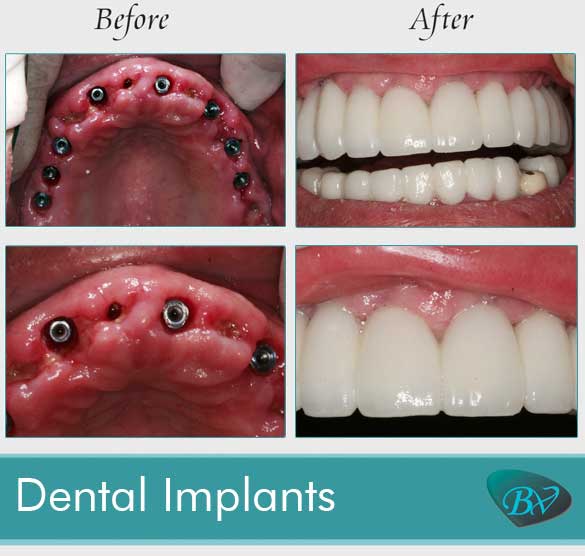Dental Sense for Beginners
Dental Sense for Beginners
Blog Article
Everything about Dental Sense
Table of ContentsRumored Buzz on Dental SenseThe 8-Minute Rule for Dental SenseHow Dental Sense can Save You Time, Stress, and Money.Everything about Dental Sense
are clinical devices surgically implanted into the jaw to recover a person's ability to chew or their look. They give support for fabricated (fake) teeth, such as crowns, bridges, or dentures. When a tooth is shed as a result of injury or condition, a person can experience complications such as rapid bone loss, defective speech, or modifications to eating patterns that lead to discomfort.Oral implant systems contain a dental implant body and oral implant joint and might additionally include a joint fixation screw. Dental veneers cost. The dental implant body is operatively inserted in the jawbone instead of the tooth's root. The oral implant abutment is generally connected to the implant body by the abutment fixation screw and prolongs with gum tissues right into the mouth to support the affixed synthetic teeth
(https://pxhere.com/en/photographer-me/4492670)Structure of The Dental Implant System picking oral implants, speak to your dental provider regarding the prospective advantages and dangers, and whether you are a candidate for the treatment. Things to take into consideration: Your overall health and wellness is a crucial consider identifying whether you are a great prospect for dental implants, for how long it will certainly take to recover, and for how long the dental implant may stay in place.
Smoking cigarettes may impact the recovery procedure and lower the lasting success of the implant. The healing procedure for the implant body may take a number of months or longer, during which time you typically have a short-lived abutment instead of the tooth. the dental implant treatment: Very carefully follow the oral hygiene directions provided to you by your oral copyright.
Some Known Incorrect Statements About Dental Sense
Implant failing can cause the requirement for one more operation to take care of or replace the dental implant system. Brings back the ability to chew Brings back cosmetic appearance Aids keep the jawbone from shrinking as a result of bone loss Preserves the health of the bordering bone and periodontals Assists keep nearby (nearby) teeth stable Boosts lifestyle Damages to surrounding all-natural teeth during dental implant positioning Injury to the surrounding tissues throughout surgical treatment, such as sinus opening Injury during surgery (for instance, crack of bordering jawbone) Insufficient feature, such as feeling like the teeth do not bite with each other generally A feeling that the tooth hangs or turning in area arising from a joint screw loosening Implant body failure (looseness of the dental implant body) because of systemic infection, which may be more probable in individuals with unchecked diabetics issues due to local infection in bone and gums supporting the implant body because of postponed recovery, which may be a lot more most likely in people that smoke Trouble cleaning up the periodontals around the dental implant, causing poor oral hygiene Without treatment periodontal disease Post-surgical pins and needles because of nerve impingement or damage Always notify wellness treatment carriers and imaging specialists that you have oral implants hop over to here before any magnetic vibration imaging (MRI) or x-ray procedures.
FDA is not conscious of any kind of unfavorable events reported for MRI or x-ray treatments with oral implants. Dental implants systems are normally made of materials that follow international consensus criteria of the International Company for Standardization (ISO) or ASTM International. These criteria have information of what makes a risk-free material.

An oral implant is a framework that replaces a missing out on tooth. With screw-like devices, the doctor inserts an implant into the jawbone, and it acts as an anchor for an artificial tooth, called a crown.
The Ultimate Guide To Dental Sense
Some people are not qualified for dental implant surgical treatment. It is for dental cosmetic surgeons to run on people with: intense illnessuncontrollable metabolic diseasebone or soft cells illness or infectionIf these problems are fixed, an individual can have the surgery. In, oral doctors avoid operating people with: If individuals with any of the above go through oral implant surgical treatment, there is a higher danger of the dental implant failing.

Oral implant surgical treatment is a personalized procedure. It's not the very same for everyone. But the following provides a basic summary of what you can expect your dental practitioner, dental specialist, periodontist or prosthodontist to do: Position the implant operatively. Offer you time to recover. Attach the article and last crown, bridge or denture.
Next, your cosmetic surgeon will very carefully put the dental implant right into your jaw. If your implant is near the front of your mouth, your dentist will certainly make a short-term tooth for you to wear until you heal.
Get This Report on Dental Sense
Your copyright can tell you what to anticipate in your circumstance. During the recovery phase, your jawbone must fuse to the oral implant. This procedure, called osseointegration, is essential for security and long-term success. This process can take anywhere from three to 9 months. In some situations, it may take longer.
When your implant heals, your dentist can affix the abutment (little adapter message) and your last reconstruction (crown, bridge or denture). This typically takes about one hour to finish and might need a second minor surgery. You should not feel any type of discomfort throughout your dental implant procedure since your company will certainly utilize medicine to numb your gums.
Report this page